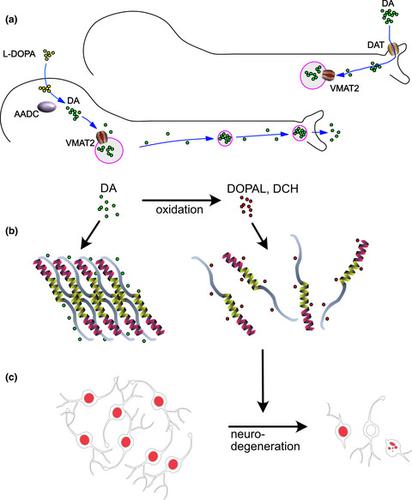当前位置:
X-MOL 学术
›
J. Neurochem.
›
论文详情
Our official English website, www.x-mol.net, welcomes your
feedback! (Note: you will need to create a separate account there.)
Dopamine promotes the neurodegenerative potential of β‐synuclein
Journal of Neurochemistry ( IF 4.2 ) Pub Date : 2020-07-30 , DOI: 10.1111/jnc.15134 Anupam Raina 1 , Kristian Leite 1 , Sofia Guerin 1 , Sameehan U Mahajani 1 , Kalyan S Chakrabarti 2 , Diana Voll 1 , Stefan Becker 2 , Christian Griesinger 2 , Mathias Bähr 1 , Sebastian Kügler 1, 3
Journal of Neurochemistry ( IF 4.2 ) Pub Date : 2020-07-30 , DOI: 10.1111/jnc.15134 Anupam Raina 1 , Kristian Leite 1 , Sofia Guerin 1 , Sameehan U Mahajani 1 , Kalyan S Chakrabarti 2 , Diana Voll 1 , Stefan Becker 2 , Christian Griesinger 2 , Mathias Bähr 1 , Sebastian Kügler 1, 3
Affiliation

|
A contribution of α‐Synuclein (α‐Syn) to etiology of Parkinson´s disease (PD) and Dementia with Lewy bodies (DLB) is currently undisputed, while the impact of the closely related β‐Synuclein (β‐Syn) on these disorders remains enigmatic. β‐Syn has long been considered to be an attenuator of the neurotoxic effects of α‐Syn, but in a rodent model of PD β‐Syn induced robust neurodegeneration in dopaminergic neurons of the substantia nigra. Given that dopaminergic nigral neurons are selectively vulnerable to neurodegeneration in PD, we now investigated if dopamine can promote the neurodegenerative potential of β‐Syn. We show that in cultured rodent and human neurons a dopaminergic neurotransmitter phenotype substantially enhanced β‐Syn‐induced neurodegeneration, irrespective if dopamine is synthesized within neurons or up‐taken from extracellular space. Nuclear magnetic resonance interaction and thioflavin‐T incorporation studies demonstrated that dopamine and its oxidized metabolites 3,4‐dihydroxyphenylacetaldehyde (DOPAL) and dopaminochrome (DCH) directly interact with β‐Syn, thereby enabling structural and functional modifications. Interaction of DCH with β‐Syn inhibits its aggregation, which might result in increased levels of neurotoxic oligomeric β‐Syn. Since protection of outer mitochondrial membrane integrity prevented the additive neurodegenerative effect of dopamine and β‐Syn, such oligomers might act at a mitochondrial level similar to what is suggested for α‐Syn. In conclusion, our results suggest that β‐Syn can play a significant pathophysiological role in etiology of PD through its interaction with dopamine metabolites and thus should be re‐considered as a disease‐relevant factor, at least for those symptoms of PD that depend on degeneration of nigral dopaminergic neurons.
中文翻译:

多巴胺可促进β-突触核蛋白的神经退行性能力
目前尚无人认为α-突触核蛋白(α-Syn)对帕金森氏病(PD)和路易体痴呆(DLB)病因的贡献,而密切相关的β-突触核蛋白(β-Syn)对这些疾病的影响疾病仍然是个谜。长期以来,β-Syn一直被认为是α-Syn的神经毒性作用的衰减剂,但在PD的啮齿动物模型中,β-Syn诱导了黑质多巴胺能神经元的强烈神经变性。鉴于多巴胺能神经元对PD的神经退行性有选择性,我们现在研究多巴胺是否可以促进β-Syn的神经退行性潜力。我们发现,在培养的啮齿动物和人类神经元中,无论多巴胺是在神经元内合成还是从细胞外空间摄取,多巴胺能神经递质表型均能显着增强β-Syn诱导的神经变性。核磁共振相互作用和硫黄素-T掺入研究表明,多巴胺及其氧化代谢物3,4-二羟基苯基乙醛(DOPAL)和多巴氨基色素(DCH)直接与β-Syn相互作用,从而实现结构和功能上的修饰。DCH与β-Syn的相互作用会抑制其聚集,这可能导致神经毒性寡聚β-Syn的水平升高。由于保护线粒体外膜的完整性阻止了多巴胺和β-Syn的加性神经退行性作用,因此此类低聚物的线粒体水平可能与α-Syn相似。总之,我们的结果表明,β-Syn通过与多巴胺代谢产物的相互作用在PD的病因中起重要的病理生理作用,因此应重新考虑为疾病相关因素,
更新日期:2020-07-30
中文翻译:

多巴胺可促进β-突触核蛋白的神经退行性能力
目前尚无人认为α-突触核蛋白(α-Syn)对帕金森氏病(PD)和路易体痴呆(DLB)病因的贡献,而密切相关的β-突触核蛋白(β-Syn)对这些疾病的影响疾病仍然是个谜。长期以来,β-Syn一直被认为是α-Syn的神经毒性作用的衰减剂,但在PD的啮齿动物模型中,β-Syn诱导了黑质多巴胺能神经元的强烈神经变性。鉴于多巴胺能神经元对PD的神经退行性有选择性,我们现在研究多巴胺是否可以促进β-Syn的神经退行性潜力。我们发现,在培养的啮齿动物和人类神经元中,无论多巴胺是在神经元内合成还是从细胞外空间摄取,多巴胺能神经递质表型均能显着增强β-Syn诱导的神经变性。核磁共振相互作用和硫黄素-T掺入研究表明,多巴胺及其氧化代谢物3,4-二羟基苯基乙醛(DOPAL)和多巴氨基色素(DCH)直接与β-Syn相互作用,从而实现结构和功能上的修饰。DCH与β-Syn的相互作用会抑制其聚集,这可能导致神经毒性寡聚β-Syn的水平升高。由于保护线粒体外膜的完整性阻止了多巴胺和β-Syn的加性神经退行性作用,因此此类低聚物的线粒体水平可能与α-Syn相似。总之,我们的结果表明,β-Syn通过与多巴胺代谢产物的相互作用在PD的病因中起重要的病理生理作用,因此应重新考虑为疾病相关因素,











































 京公网安备 11010802027423号
京公网安备 11010802027423号